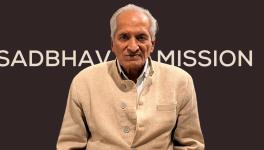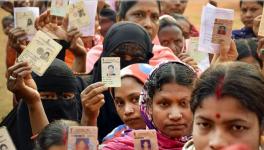For Better City Governance, Local Body List is a Must
The recent elections to the city governments, called the urban local bodies, in a few states like Tamil Nadu, Odisha, West Bengal etc., have proven one fact hard and straight-the city governments are no more than adjuncts of the state governments.
Invariably, in all the above states where city polls were held, and in most states, the general trend of elections in these local bodies is to vote for the ruling party candidates. The urban electorate that is scorching under faulty urbanisation policies thinks of getting some relief if the city government also happens to be politically in sync with the state government. A general understanding is that the city will get more flow of money, more projects, and more developmental work. This does not happen.
Charles Correa, the famous architect and chairperson of the first Urban Commission in India, formed during the mid-1980s, said: The cities and state governments must compete for healthy development. The elected council or the mayors hardly run the cities. Instead, the chief ministers run the affairs of the city governments, ensuring complete control over policy matters.
In Delhi, the Central government wants to take control of the city affairs bypassing the two governance structures-state government and the municipal corporation. The planning in Delhi is already in the hands of the Central government. The Delhi Development Authority does the planning by writing the master plans for the city-state under the Central government.
The Centre now wants to further control the city by unifying the three municipal corporations into one single municipal corporation, hoping that the BJP will win with this unification. Well, that is for the people to decide. But without considering people in either trifurcating the single municipal corporation or now unifying the three municipal corporations smacks of the total lack of apathy for the people’s participation in the decision-making process.
Why is it that the people are hardly taken into confidence on policy matters, thus alienating them further? There may be many reasons for such behaviour in the governance structure. However, let me cite one of the principal ones. Urban planning is a state subject. There are three lists under the Indian Constitution. The union list, state list and the concurrent list. A state list means that the state governments are supposed to be handling the subjects mentioned in the list.
State governments directly control urban planning, being a state subject. Since the 1980s, there has been a debate on the importance of urban planning. The first urban commission made some recommendations. Then there was a constitutional amendment called the 74th Constitutional Amendment. According to this amendment, 18 subjects were supposed to be transferred to the city governments.
These include:- urban planning; regulation of land use; planning for economic development; roads and bridges; water supply; public health; fire services; urban forestry; safeguarding interests of weaker sections; slum improvement; urban poverty alleviation; urban amenities like parks etc.; promotion of cultural aspects; burial and cremation grounds; cattle ponds, prevention of cruelty against animals; registration of births and deaths; public amenities-street lighting, parking lots, bus stops etc.; regulation of abattoirs etc.
This was supposed to be supported by three F's-functionaries, functions and finances. However, shockingly, not more than three to four functions have been transferred to the city governments universally across the Indian nation. Most of the functions are still under the state governments, and the elected councils have to be at the complete functional mercy of the state governments.
Cities produce phenomenal wealth. More than 66% of the country’s GDP comes from cities. They consume the biggest share of energy and have a very large consumer base. In recent decades, the large capital (even transnational capital) is now viewing Indian cities as avenues for increasing their profits. In order to do this, the most important tool in the process of city planning. This process decides the land use in a city and how the capital must move with economic prospects flowing from real estate, etc.
The second area is the privatisation of utilities which has taken rapidly in the recent period. Water, sanitation, health, electricity, education, and the list are sectors where private capital has ventured to maximise its profits. And all this is done in the guise of better performance and efficiency. The state does not want to lose these important governance sectors, both for economic and political reasons.
An interesting reality came to light while reviewing the 74th Constitutional Amendment from 2012 to 14 (this was done by a team headed by KC Sivaramakrishnan, former urban development secretary; I was also a team member). The Mumbai mayor, after her term, wants to become an MLA. Mumbai city has perhaps five MPs and nearly 30 MLAs. Still, a mayor after her term would aspire to be an MLA. The progression is clear that it speaks about the necessity to change the present set of urban governance.
CREATE A LOCAL BODY LIST
It is high time that we start looking beyond the prism of the 74th constitutional amendment. There is no point in pushing for its implementation. What is required in the present setup is a clear distinction between the subjects that must be transferred to the city governments. Instead of a vague direction that flowed from the above amendment without making it mandatory for the states, a new list must be created to handle the urban system. Why?
There has been a massive change in urban dynamics in the last few decades. Nearly 40% of the people now live in urban centres. The multiplicity of governance is making even simpler things complex and affecting the services in the cities. There has also been a complete metamorphosis in the labour structure. The social reproduction of capital is now dominating the cities instead of being large manufacturing hubs.
In simpler terms, things that were supposed to be done at the family level have now taken a different shape in social production. There is a new platform-based economy that is now witnessed in most cities. The informal sector workers have increased phenomenally, with their bargaining capacity dwindling phenomenally. Migration is a big phenomenon that was not a dominant factor during the early 1990s.
The impact of climate change is evident in the cities. We have one of the worst polluted cities in the world. Urban commons and biodiversity are being robbed in one of the most unsustainable forms of urbanisation.
Even urban governance is further alienating the people in the decision-making process. There is hardly any participation of the people in deciding their urban futures. The smart city-SPV model is bureaucratically controlled with no people’s participation.
HOW MUST IT BE DONE?
Akin to the state cadre of officers, there must be a separate cadre of officials for the local bodies. Public services like health, water, sanitation, education, fire services, housing, and the social sector must be completely under the local bodies. Likewise, city planning must be the domain of the city government. The departments must be transferred for capacity building. Climate change, biodiversity, disaster mitigation and adaptation must be transferred to the local body list.
The challenge could be with some of the issues that are peripheral in nature. For that, a dialogue mechanism should be built to ensure that the city and its periphery work in tandem. The finances must equally be transferred to the city governments, and this should flow right from the GST to the income tax. A nominal 10% of the total income tax collected from the city governments should be transferred to the cities respectively. This can be a good starter.
For the cities and their people to lead a secure and liveable future, it is necessary that the tools of planning are handed over to them and not restricted to only professionals. This will also bring the most creative forms of urban development to the fore. Sooner the better.
Get the latest reports & analysis with people's perspective on Protests, movements & deep analytical videos, discussions of the current affairs in your Telegram app. Subscribe to NewsClick's Telegram channel & get Real-Time updates on stories, as they get published on our website.
























